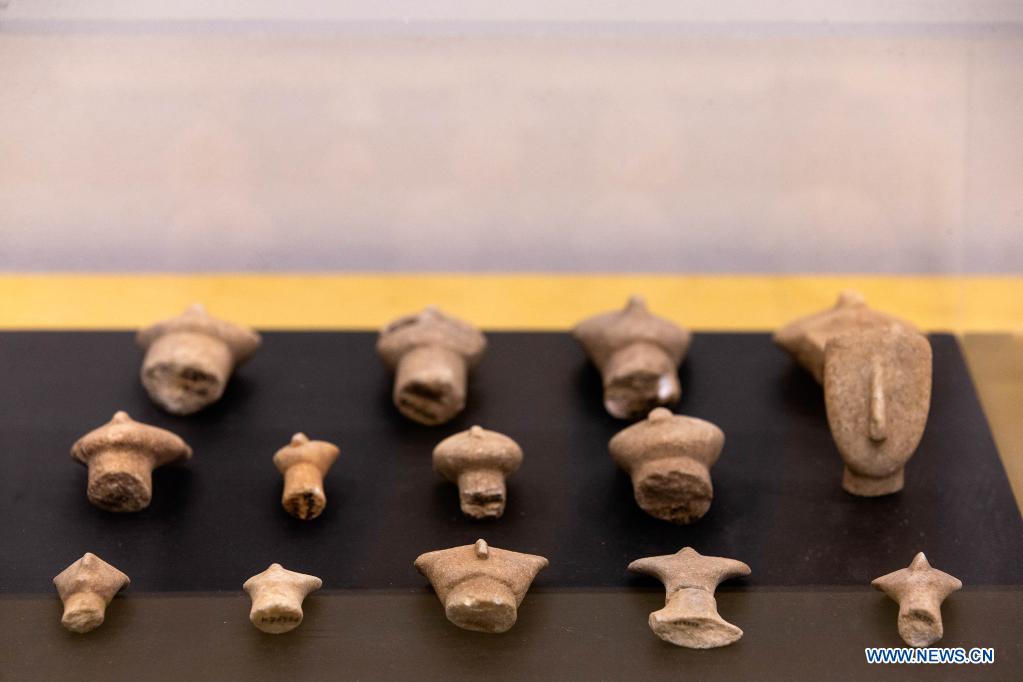
Artifacts are seen at the exhibition "Look Across: A Settlement on Keros 4,500 years Ago" at Athens Municipal Gallery in Athens, Greece, on June 1, 2021. (Xinhua/Marios Lolos)
ATHENS, June 4 (Xinhua)-- The archaeological treasures from the Aegean Sea Keros island, an important center of the Cycladic civilization which flourished in the early Bronze Age in this region, are now on display at the Gallery of the Municipality of Athens.
The exhibition titled "Look Across: A Settlement on Keros 4,500 years Ago" has traveled to the Greek capital with the aim to introduce to a wider audience for the first time the significant findings of the excavations carried out in recent years.
It was first presented to the public in 2019 on a small island in the Cyclades complex.
Keros, a 15-square-km rocky island which is nowadays uninhabited, is located near Naxos island in the Cyclades and has been described by experts as the world's first maritime sanctuary.
Many excavations have taken place at various times since the 1960s. Marble figurines and vessels, ceramics as well as stone objects were found scattered. Archaeologists believe they had been deposited on the island during rituals.
"Cycladic islanders traveled to Keros to deposit pieces of these fragmented artefacts for rituals. What remains a mystery is the parts of artefacts that did not reach Keros. Did they take them back with them, or did they remain on the traveler's island?" Stefanos Keramidas, archaeologist-museologist of the Ephorate of Antiquities of Cyclades, also curator of the exhibition, explained to Xinhua.
Recent excavations on the nearby islet of Dhaskalio, which was connected to Keros centuries ago, have revealed a particularly significant settlement of the Cycladic civilization that was inhabited for 500 years.
The habitants had advanced architecture, as well as extensive contacts with both neighboring islands and distant civilizations.
"Metallurgic equipment, artefacts, ceramics discovered there appear to have come from other Cycladic islands. Also, the food traces indicate that habitants had seeds of grapes, olives, figs, and cereals, and jewels that came from other places," Keramidas explained.
Visitors will have the opportunity to explore the mystery of the scattered marble figurines and vessels from Keros and the findings from the prehistoric settlement of Dhaskalio.
"The exhibition is articulated in three axes. In the first part, we want to set the geographical location, where is Keros in relation to Cyclades and the rest of the world. In the main hall, we have the most important findings from Keros and Dhaskalio," Keramidas told Xinhua.
According to the archaeologist, the exhibits highlight the start of urbanization and the maritime trade networks for raw materials and goods in the Aegean Sea during the prehistoric era.
"And, at the end, we present the excavation process, carried out with the use of advanced and innovative technologies, and the demanding work of archaeologists and researchers under particularly difficult soil and climatic conditions in order to preserve our cultural heritage," he noted.
The latest discoveries conducted by a team of scientists from the University of Cambridge, the Ephorate of Antiquities of Cyclades and the Cyprus Institute, highlighted the special importance of this place during the early Bronze Age.
The exhibition, organized by the Ephorate of Antiquities of Cyclades in cooperation with the City of Athens Culture, Sports and Youth Organization (OPANDA), will run till the end of August at the Gallery with free admission. Enditem